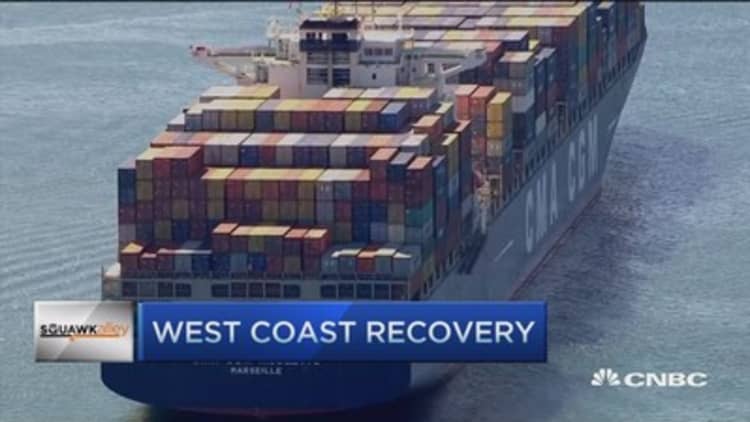
Cranes are moving, trucks are cruising (mostly), and business is booming at the nation's largest container port complex. Volumes in June jumped 14 percent at the Port of Los Angeles to a three-year high. Next door at the Port of Long Beach, June volumes were up 8 percent.
That's good news after overall volume fell 5 percent last winter during a contract dispute between dockworkers and shipping companies. Imports plummeted 20 percent in January and February, according to trade research firm Zepol.
So is business back to normal?
"Oh yes, absolutely," said Eugene Seroka, LA Port executive director.
"We're well ahead of last year," said his counterpart at the Port of Long Beach, CEO Jon Slangerup.
Not a moment too soon. Retailers will soon start shipping for the holiday season, and West Coast ports have to re-establish confidence and efficiency. Both were lost after the slowdown created epic congestion.
"There's been a lot of improvement, particularly since May," said Bruce Robertson, founding partner of BGI Worldwide Logistics. However, "I still think 25 percent of the trucks get stuck in the port for more than two hours."
There's also still a shortage of truck chassis to carry containers off port property. Jonathan Rosenthal of Saybrook Capital is now chairman of Eco Flow, a trucking company. While most truckers at the port are independent contractors, Eco Flow's drivers are actual employees.
"The real problem in the industry today is the management of data, knowing what needs to be where when, and that's something we're working on," said Rosenthal, who has spent much of his career investing in logistics.
Managing everything better is even more critical given the Panama Canal expansion project that will be completed next year, allowing bigger ships to sail from China directly to the East Coast and skip California. C.H. Robinson's Sri Laxmana predicted there will be a permanent shift of some traffic.
Read MoreCanada is on the brink of a 'very unusual recession'
"Ten percent is certainly what we estimate. ... It gives a lot of options to shippers out here," he said. "The key theme is diversity."
"Will the Panama Canal have an impact? Yes. I've heard varying stories. I don't think you'll know until after the fact," said Rosenthal. "Clearly if the port complex, LA and Long Beach, don't come together and work cooperatively to increase efficiencies, then obviously places like Miami and Houston will have a more competitive advantage over this port."
It's not just the Panama Canal that threatens the West but also increased traffic through the Suez Canal, where a 21-mile extension just opened for business, and improved ports in Canada and Mexico.
"All these folks are coming after us in varying ways, because when you're the number one port in the nation, folks will look to get your business," said LA Port's Seroka. "We're being as assertive as possible, because we believe we are the fastest and most efficient way to the interior of the U.S."
Long Beach's Slangerup believes the bottom line is the bottom line. He said on average it costs $1,800 and 17 days to ship a container from Shanghai through California to Chicago. It can cost $4,200 and a week longer to get to Chicago through the East Coast.
That's not all. "More than half of the ships on order in this industry are too big to go through the (expanded) Panama Canal," Slangerup said. Ships carrying 16,000 TEUs won't make it through (a TEU is the equivalent of a 20-foot container). Slangerup considers the canal expansion a "nonevent," saying most large customers have already positioned themselves throughout the country with warehouses to hedge against port problems in any one area.
Read MoreJPMorgan to move 2,150 jobs from NY to NJ: Report
Still, change is in the air, or at least on the sea. "You had a lot of retailers who did shift their cargoes to the East Coast and Gulf Coast ports, as well as Canada (during the slowdown), and many of them still have not shifted that cargo back to the West Coast," said Jonathan Gold of the National Retail Federation. "Even with the contract in place today, we're still seeing issues with congestion for a variety of reasons, so I think the ports on the West Coast really need to work on solving some of those issues."
Southern California ports are spending nearly $6 billion on a massive facelift. Automation and cleaner energy are the big investments, including $2 billion being spent to turn the Long Beach Container Terminal into a fully automated and electric facility capable of handling the biggest container ships in the world. New algorithms will allow containers to be stacked more efficiently, and the hope is that many containers won't have to be stacked at all but go directly onto rail cars.
"We have customers with 21,000-TEU ships on order," said Slangerup. "These are ultra large, mega-ships, an they can only come to this port complex."


